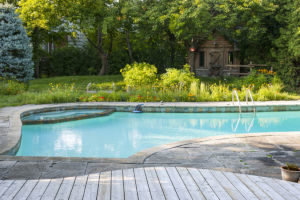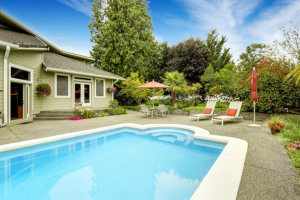 If your pool is falling into disuse, it may be time to consider a pool removal. While you might not realize it yet, that pool is still costing you in hidden expenses simply by being in your backyard. Those costs were always there, and you may have been paying for them this whole time without knowing just how much you were spending. Now that the pool remains unused for the majority of the spring and summer seasons, though, those costs might become a bit more apparent.
If your pool is falling into disuse, it may be time to consider a pool removal. While you might not realize it yet, that pool is still costing you in hidden expenses simply by being in your backyard. Those costs were always there, and you may have been paying for them this whole time without knowing just how much you were spending. Now that the pool remains unused for the majority of the spring and summer seasons, though, those costs might become a bit more apparent.
Inground Pools & The Hidden Costs
Avoid the hidden costs of a backyard pool by having it removed, and enjoy your backyard on your own terms this spring and summer.
Retaining Walls
Retaining walls keep your pool and decking stable while ensuring that your yard can drain properly. They are particularly useful in situations where the pool is placed on a sloped area. However, many homeowners don’t realize that retaining walls are not only necessary — they’re expensive. While the cost of a retaining wall differs depending on the size, materials used, and decorative features selected, estimates typically begin around $7,000. Additional decoration, such as tile or even waterfalls, can bring the price up to $20,000. If your pool does not yet have a retaining wall, you can install one to help prevent dirt slippage and water draining, though having the pool removed entirely can be a more affordable option.
Extra Concrete
Your pool isn’t going to sit in the middle of your lawn, with no border around it. Instead, it will have its own patio area for both practical and aesthetic purposes. What many homeowners forget is that having some extra space around the pool creates a more enjoyable experience. Instead of stepping directly onto the grass after leaving the pool, or setting up your deck chairs on the lawn, an additional 300 to 700 square feet of concrete can create the perfect amount of space for a more relaxing pool area. If you haven’t considered this before the pool is installed, or if you purchase a house without the proper amount of patio space, adding it in can become a costly headache that requires additional landscaping, materials, and labor costs.
Landscaping
Landscaping doesn’t end when your pool is installed, though replacing grass and other features after the process can be daunting. Your yard must be meticulously managed to help prevent clogged filters and bacterial growths that can occur due to plants and other organic matter that might be left in the water for too long. Landscaping costs can therefore quickly add up just for regular maintenance. In the event that your pool overflows, your yard can sustain serious damage. You may need to replace grass, flowers, and other outdoor features in the aftermath, costing far more than you may have expected or planned to spend for pool-related emergencies.
Electrical and Water Expenses
 All of the equipment in your pool, from the filters and lights to the pumps and generators, runs on electricity. To some, this fact can be easily overlooked. Depending on your equipment, your utilities bill can increased by $300 per year, which quickly adds up the longer you have your pool. Additional expenses can be incurred if you choose to install complex lighting systems, heaters, or have a hot tub connected to your pool. Water represents an additional expense. Should you need to refill your pool, you can expect to pay between $60 and $120 for the necessary water, with a few dollars more to account for evaporation in between seasons. While it may seem small, this cost can make a big impact when paired with the many other unexpected expenses that pools present.
All of the equipment in your pool, from the filters and lights to the pumps and generators, runs on electricity. To some, this fact can be easily overlooked. Depending on your equipment, your utilities bill can increased by $300 per year, which quickly adds up the longer you have your pool. Additional expenses can be incurred if you choose to install complex lighting systems, heaters, or have a hot tub connected to your pool. Water represents an additional expense. Should you need to refill your pool, you can expect to pay between $60 and $120 for the necessary water, with a few dollars more to account for evaporation in between seasons. While it may seem small, this cost can make a big impact when paired with the many other unexpected expenses that pools present.
Fencing and Safety
Fencing and other safety equipment is essential for any pool. This equipment can be costly, particularly if your pool was built without consideration for a fence. A sturdy fence should be staked into the ground to prevent children and unwanted guests from knocking it over, and installing a strong fence can get expensive if it requires drilling into concrete or digging into the hard soil. Maintenance and repairs for fencing can also add up over time if the fence is not properly looked after for several years, which may happen if your pool is used infrequently.
The Value of a Pool Removal
Removing your pool requires a large initial investment that generates significant savings after just a few years. Annual pool costs typically average between $3,000 and $5,000 per year, depending on the size of the pool and its unique considerations. A pool removal, meanwhile, costs between $3,000 and $15,000, depending on the size of the pool, complexity of the project, and the type of pool removal selected. Homeowners with lower pool costs who select a partial pool removal will begin to see savings in just two years, while those with more expensive pools who choose a full pool removal will have to wait a little longer — at least four years — to reap the rewards. In either case, the money spent on removing your pool will help you create a safer, more affordable, and more enjoyable backyard that will require less daily maintenance and lighten the strain that your home places on your finances over time.
Contact A Professional Pool Removal Contractor
Contact a professional pool removal contractor for more information about pool removal services and to receive a free estimate for your project. Dirt Connections offers full and partial pool removal services for homeowners in the Northern Virginia and Maryland areas. Each of these removals has their own benefits and drawbacks, and a pool removal contractor can help you determine the best one for you based on the size of your pool, your plans for your backyard, and your budget. The firm prides itself on completing projects in a professional, timely, and clean manner, allowing you to begin enjoying your new yard right away.








































